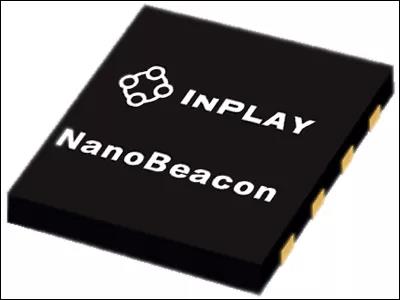Technology startup InPlay Technologies has built a new integrated circuit (IC) designed to make active RFID technology relatively cheap and easy to deploy through Bluetooth Low Energy (BLE).
InPlay’s SoC called IN100NanoBeacon was launched in 2021. It uses the Bluetooth 5.0 standard (a BLE with remote capability) to implement a low-cost, compact beacon module. It is powered by a button battery and can be paired with the sensor. Pre-configured for event trigger conditions.
San Jose, California solution provider BeeFi plans to trial IN100 NanoBeacon in the next few months and is expected to deploy in early 2022. InPlay also plans to cooperate with other partners to develop low-cost solutions that can not only locate devices but also capture sensor data.
The minimum package size of this SoC (DFN8) is 2.5x 2.5 ㎜ (0.1 x 0.1 inches). It can be built into a beacon device powered by a 1.5 volt button battery and can be fixed on a set of equipment, a container or a wall. Then configure it with the help of an application without software development. SoC development does not require software programming.

IN100NanoBeacon SoC
IN100 NanoBeacon supports the remote function of Bluetooth 5.0, which can transmit data up to several hundred meters. David Hu pointed out that due to the high level of silicon integration and only a peripheral 26 MHz crystal is required, the size of the IN100-based beacon module is only a small part of the size of most beacon hockey pucks. The technology supports Eddystone and iBeacon protocols.
BeeFi, a company co-founded by David Hu and his former high school classmate John Yu, has been manufacturing IoT systems for Qualcomm. Qualcomm's AWS-ready module uses Wi-Fi connection. David Hu explained: "We provide them with a Bluetooth version of the IoT solution."
Headquartered in Irvine, California, InPlay was founded in 2016 by engineers from Atmel (now Microchip) to tackle technical challenges involving games, robotics, and industrial systems. David Hu said: "We are concerned about the game because the low-latency wireless problem has not been resolved.”
However, the company also focuses on industrial applications that can benefit from the same technology. "Then we made the first chip, a multi-protocol Bluetooth, low latency, and SDR (software defined radio) for networking. The SDR edge network solution is designed to connect tens of thousands of devices and also supports the Bluetooth 5.0 protocol. ."
"At that time, we thought that the power consumption of Bluetooth beacons must be reduced. Can a different architectural approach be used to solve this problem?"
Only a PC tool is needed to configure the SoC,The user can select and set parameters in the option list on the tool(For example, set to no more than 35°C),Then burn these settings to the chip. This technology is likely to be used to locate and monitor assets and equipment in warehouses, manufacturing sites, and medical institutions in real time. For example, it can be connected to high-value items. After that, users use a single BLE gateway to capture potential data from thousands of devices and use it. Transfer to the server; in the warehouse, users can view the location and status of their tools, forklifts or pallets, and view the collected data through applications on smartphones or tablet devices.
In terms of location tracking, BeeFi's SensiBLE IoT platform uses InPlay's IN100 SoC and IN612L two-way SDR protocol edge network SoC in its gateway, and uses a combination of arrival angle and received signal strength indicator algorithm to achieve 1 meter (3.3 Feet) within the real-time tag positioning accuracy, while also capturing sensor data. The company said that because the SoC uses so little power, it may use solar, radio or mechanical power.
In order to serve this market, InPlay expects to continue to develop NanoBeacon in order to sell it as an automotive-grade product. The company reports that IN100 comes with a unique private key to provide security and identity verification. If the private key is compromised, the corresponding beacon will be deleted and removed from the authentication server, making it unusable. In addition, the sensor payload is encrypted, and only the owner of the key can decrypt and verify the authenticity of the message.
In order to support its current and future partners, InPlay plans to selectsell IN100 evaluation kits before the end of this year.






